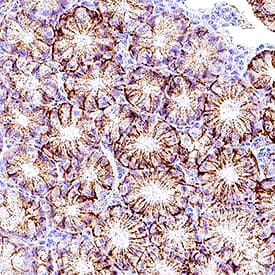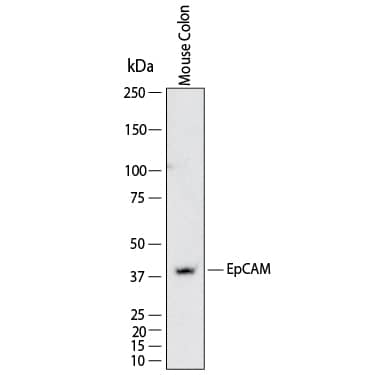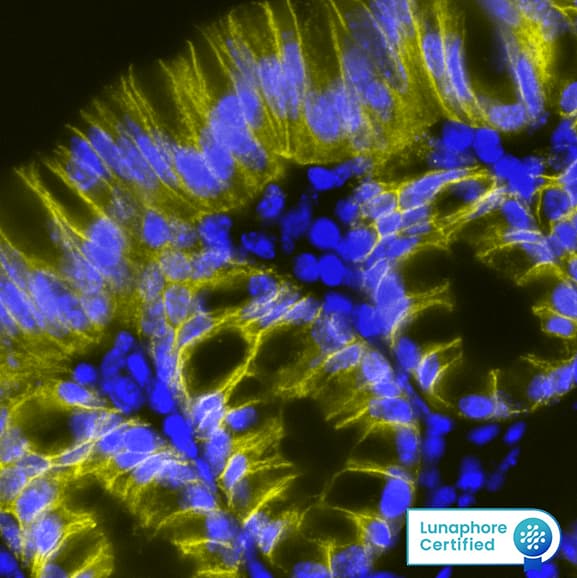Mouse
EpCAM/TROP-1 Antibody
R&D Systems, part of Bio-Techne | Catalog # MAB11623

Key Product Details
Species Reactivity
Mouse
Applications
Immunohistochemistry, Multiplex Immunofluorescence, Western Blot
Label
Unconjugated
Antibody Source
Monoclonal Rat IgG2B Clone # 1085639
Product Specifications
Immunogen
Mouse myeloma cell line NS0-derived recombinant mouse EPCAM
Accession # Q99JW5
Accession # Q99JW5
Specificity
Detects recombinant mouse EPCAM protein in Direct ELISA.
Clonality
Monoclonal
Host
Rat
Isotype
IgG2B
Scientific Data Images for Mouse EpCAM/TROP-1 Antibody
Detection of EPCAM in Mouse Colon via seqIF™ staining on COMET™
EPCAM was detected in immersion fixed paraffin-embedded sections of mouse Colon using Rat Anti-Mouse EPCAM, Monoclonal Antibody (Catalog # MAB11623) at 20ug/mL at 37 ° Celsius for 4 minutes. Before incubation with the primary antibody, tissue underwent an all-in-one dewaxing and antigen retrieval preprocessing using PreTreatment Module (PT Module) and Dewax and HIER Buffer H (pH 9; Epredia Catalog # TA-999-DHBH). Tissue was stained using the Alexa Fluor™ 647 Goat anti-Rat IgG Secondary Antibody at 1:200 at 37°Celsius for 2 minutes. (Yellow; Lunaphore Catalog # DR647RT) and counterstained with DAPI (blue; Lunaphore Catalog # DR100). Specific staining was localized to the membrane. Protocol available in COMET™ Panel Builder.Detection of EpCAM/TROP-1 in Mouse Colon.
EpCAM/TROP-1 was detected in immersion fixed paraffin-embedded sections of mouse colon using Rat Anti-Mouse EpCAM/TROP-1 Monoclonal Antibody (Catalog # MAB11623) at 5 µg/ml overnight at 4 °C. Before incubation with the primary antibody, tissue was subjected to heat-induced epitope retrieval using VisUCyte Antigen Retrieval Reagent-Basic (Catalog # VCTS021). Tissue was stained using the HRP-conjugated Anti-Rat IgG Secondary Antibody (Catalog # HAF005) and counterstained with hematoxylin (blue). Specific staining was localized to the membrane of glandular epithelial cells. View our protocol for Chromogenic IHC Staining of Paraffin-embedded Tissue Sections.Detection of Mouse EpCAM/TROP-1 by Western Blot.
Western Blot shows lysates of mouse colon tissue. PVDF membrane was probed with 4 µg/ml of Rat Anti-Mouse EpCAM/TROP-1 Monoclonal Antibody (Catalog # MAB11623) followed by HRP-conjugated Anti-Rat IgG Secondary Antibody (Catalog # HAF005). A specific band was detected for EpCAM/TROP-1 at approximately 40 kDa (as indicated). This experiment was conducted under reducing conditions and using Western Blot Buffer Group 1.Applications for Mouse EpCAM/TROP-1 Antibody
Application
Recommended Usage
Immunohistochemistry
3-25 µg/mL
Sample: Immersion fixed paraffin-embedded sections of mouse colon
Sample: Immersion fixed paraffin-embedded sections of mouse colon
Multiplex Immunofluorescence
20 µg/mL
Sample: Immersion fixed paraffin-embedded sections of mouse Colon tissue
Sample: Immersion fixed paraffin-embedded sections of mouse Colon tissue
Western Blot
4 µg/mL
Sample: Mouse colon tissue
Sample: Mouse colon tissue
Formulation, Preparation, and Storage
Purification
Protein A or G purified from cell culture supernatant
Reconstitution
Reconstitute lyophilized material at 0.2 mg/ml in sterile PBS. For liquid material, refer to CoA for concentration.
Formulation
Lyophilized from a 0.2 μm filtered solution in PBS with Trehalose.
Shipping
Lyophilized product is shipped at ambient temperature. Liquid small pack size (-SP) is shipped with polar packs. Upon receipt, store immediately at the temperature recommended below.
Stability & Storage
Use a manual defrost freezer and avoid repeated freeze-thaw cycles.
- 12 months from date of receipt, -20 to -70 °C as supplied.
- 1 month, 2 to 8 °C under sterile conditions after reconstitution.
- 6 months, -20 to -70 °C under sterile conditions after reconstitution.
Background: EpCAM/TROP1
References
- Litvinow, S.V. et al. (1994) J. Cell Biol. 125:437.
- Balzar, M. et al. (2001) Mol. Cell. Biol. 21:2570.
- Balzar, M. et al. (1998) Mol. Cell. Biol. 18:4388.
Long Name
Epithelial Cell Adhesion Molecule
Alternate Names
17-1A, CD326, GA733-2, gp40, KS1/4, M4S1, TACSTD1, TROP1
Gene Symbol
EPCAM
UniProt
Additional EpCAM/TROP1 Products
Product Documents for Mouse EpCAM/TROP-1 Antibody
Product Specific Notices for Mouse EpCAM/TROP-1 Antibody
For research use only
